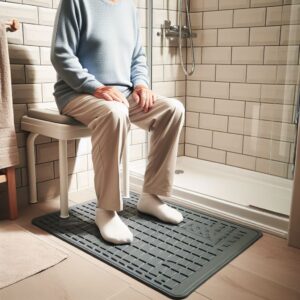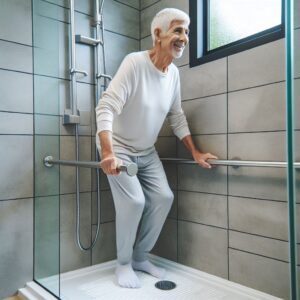Importance of Fall Prevention for Seniors
Falls are a leading cause of injury among seniors, with statistics showing that one in four older adults falls each year. Many of these falls occur in the shower. Safe showers for seniors is a must. These falls can lead to serious consequences, including fractures, hospitalizations, and a loss of independence. As we age, our bodies undergo changes that affect balance, strength, and coordination, making fall prevention a critical aspect of senior care.
Why Safe Showers Matter
The bathroom, particularly the shower area, is one of the most hazardous places for seniors. Slippery surfaces, high thresholds, and limited support structures can create a dangerous environment. Implementing safe shower solutions can significantly reduce the risk of falls, ensuring that seniors can maintain their hygiene routines without compromising their safety.
Understanding the Risks
Common Causes of Falls in the Bathroom
Several factors contribute to the high incidence of falls in the bathroom. Slippery surfaces, such as wet tiles and shower floors, are a primary concern. Poor lighting can make it difficult for seniors to see potential hazards, while the lack of grab bars and handrails leaves them without necessary support. Additionally, high thresholds and narrow spaces can impede movement and increase the risk of tripping.
Physical and Cognitive Factors
Age-related changes in balance, strength, and mobility play a significant role in fall risk. Conditions such as arthritis, osteoporosis, and muscle weakness can make it challenging for seniors to navigate the bathroom safely. Cognitive impairments, including dementia and Alzheimer’s disease, can further complicate matters by affecting judgment and spatial awareness.

Designing safe showers for seniors
Non-Slip Flooring
One of the most effective ways to prevent falls in the shower is to install non-slip flooring. Various materials, such as textured tiles, rubber mats, and adhesive strips, can provide the necessary traction to reduce the risk of slipping. When choosing non-slip flooring, consider the ease of cleaning and durability to ensure long-term safety.
When selecting non-slip flooring, it’s important to consider the specific needs of the senior using the shower. Textured tiles are a popular choice because they provide excellent traction and are available in various designs to match the bathroom decor. Rubber mats are another effective option, offering a cushioned surface that reduces the impact of falls. Adhesive strips can be applied directly to existing flooring, providing a quick and cost-effective solution. Regular cleaning and maintenance of non-slip surfaces are essential to prevent the buildup of soap scum and mold, which can reduce their effectiveness.
Grab Bars and Handrails
Grab bars and handrails are essential components of a safe shower environment. These support structures should be strategically placed near the shower entrance, within the shower itself, and around the bathroom. Stainless steel and plastic are popular materials due to their strength and resistance to corrosion. Proper installation is crucial, so ensure that grab bars are securely anchored to the wall.
The placement of grab bars and handrails is crucial for maximizing their effectiveness and ensuring safe showers for seniors. Install grab bars horizontally and vertically near the shower entrance, within the shower, and next to the toilet. This ensures that seniors have support when entering and exiting the shower, as well as while showering. Stainless steel grab bars are durable and resistant to rust, making them ideal for wet environments. Plastic grab bars are lightweight and easy to install but may not be as sturdy as metal options. Consider consulting with a professional to ensure proper installation and placement.

Shower Seats and Benches
Shower seats and benches offer a stable and comfortable option for seniors who may struggle with standing for extended periods. These seats come in various designs, including foldable, wall-mounted, and freestanding models. When selecting a shower seat, prioritize stability, ease of cleaning, and comfort.
Foldable seats can be attached to the wall and folded up when not in use, saving space in smaller bathrooms. Wall-mounted seats provide a stable and permanent solution, while freestanding benches can be moved and adjusted as needed. Look for seats with non-slip surfaces and adjustable heights to ensure comfort and safety. Some models also feature armrests and backrests for additional support. Regularly inspect shower seats for signs of wear and tear, and replace them if necessary.
Proper Lighting
Adequate lighting is vital for preventing falls in the bathroom. Ensure that the shower area is well-lit, with bright, evenly distributed light. Consider installing motion-sensor lights that automatically turn on when someone enters the bathroom. Additionally, nightlights can provide visibility during nighttime visits.
In addition to installing bright, evenly distributed lights, consider adding task lighting around the shower area. LED lights are energy-efficient and provide excellent illumination. Motion-sensor lights are particularly useful for seniors with mobility issues, as they eliminate the need to fumble for light switches. Nightlights can be placed along the bathroom floor to guide seniors during nighttime visits. Ensure that all light fixtures are securely installed and regularly check for burnt-out bulbs.
Choosing the Right Shower Equipment
Walk-In Showers
Walk-in showers are an excellent option for seniors, as they eliminate the need to step over high thresholds. These showers typically feature a low or no threshold, making them easily accessible. When installing a walk-in shower, ensure that the floor is non-slip and that grab bars are within reach.

Handheld Shower Heads
Handheld shower heads offer flexibility and ease of use for seniors. These devices allow users to direct the water flow where needed, reducing the need for excessive movement. Look for models with ergonomic handles and adjustable settings to accommodate different preferences.
Temperature Control Devices
Temperature control devices are essential for preventing burns and scalds in the shower. Thermostatic mixing valves can regulate water temperature, ensuring that it remains within a safe range. Additionally, anti-scald devices can automatically shut off the water if it becomes too hot.
Additional Safety Measures in Designing Safe Showers for Seniors
Emergency Alert Systems
Emergency alert systems can provide peace of mind for seniors and their caregivers. These systems typically include wearable devices that allow users to call for help in case of a fall or other emergency. Some models also feature automatic fall detection, which can alert caregivers even if the senior is unable to press the button.
Emergency alert systems come in various forms, including wearable devices, wall-mounted buttons, and voice-activated systems. Wearable devices, such as pendants and wristbands, allow seniors to call for help with the press of a button. Wall-mounted buttons can be installed in strategic locations around the bathroom, providing easy access in case of an emergency. Voice-activated systems are ideal for seniors with limited mobility, allowing them to call for help using voice commands. Regularly test emergency alert systems to ensure they are functioning correctly.

Regular Maintenance and Checks
Routine inspections and maintenance are crucial for maintaining a safe shower environment. Regularly check for loose tiles, worn-out non-slip mats, and malfunctioning grab bars. Create a checklist to ensure that all safety measures are in place and functioning correctly.
Create a checklist to ensure that all safety measures are in place and functioning correctly. Inspect shower seats and benches for signs of wear and tear, and replace them if necessary. Ensure that lighting fixtures are securely installed and that bulbs are not burnt out. Regularly clean non-slip surfaces to prevent the buildup of soap scum and mold. Consult with professionals for installation and maintenance to ensure that all safety measures are properly implemented.
Tips for Caregivers in Ensuring Safe Showers for Seniors
Assisting Seniors in the Shower
Caregivers play a vital role in ensuring the safety of seniors during showering. Techniques such as using a transfer bench, providing verbal cues, and assisting with washing can help reduce the risk of falls. Communication is key, so always ask the senior how you can best assist them and respect their preferences.
Creating a Supportive Environment
Encouraging independence while ensuring safety is a delicate balance. Provide seniors with the tools and support they need to shower safely, such as non-slip mats, grab bars, and shower seats. Offer emotional support and reassurance, as maintaining dignity and confidence is essential for their well-being.

Conclusion
Recap of Key Points
Putting in place safe showers for seniors is crucial for preventing falls among seniors. We can create a safer bathroom environment by addressing common hazards, such as slippery surfaces and poor lighting, and incorporating supportive structures like grab bars and shower seats. Regular maintenance and the use of emergency alert systems further enhance safety.
Encouraging Action
Taking steps to improve bathroom safety can significantly reduce the risk of falls and enhance the quality of life for seniors. Assess your bathroom for potential hazards and make necessary modifications. Consult with professionals for installation and maintenance to ensure that all safety measures are properly implemented.
References
Citing Sources and Further Reading
- Centers for Disease Control and Prevention (CDC) – Fall Statistics
- National Institute on Aging – Fall Prevention Tips
- American Geriatrics Society – Guidelines for Safe Showering
